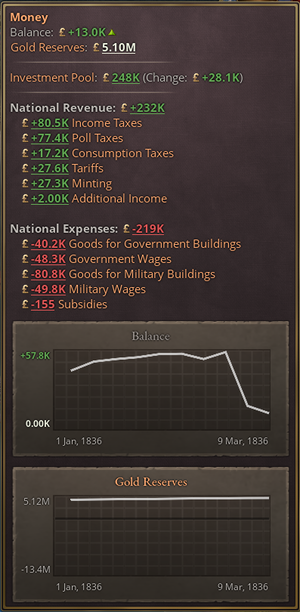国库是国家的黄金储备或贷款。国库根据国家预算增减,预算反映了国家每周收入和支出的总和。
预算余额每周一自动更新。大多数常规收入和支出(如建造)每周更新一次。此外,有一些一次性的收入或支出,如偿还债务(外交行动)、建筑物国有化或私有化,以及某些其他效应。【这也意味着,所有形式的支出(如建筑等),需要按周进行——不需要任何“手头”现金来一次开始建造十几座建筑。但若没有收入来支持,国家可能很快就会陷入债务中。】
每个独立的国家(包括附属国)都有自己的国库和预算。所有国家的所有货币都名义化为英镑。随着时间的推移,不会产生直接的通货膨胀效应;因此,1836 年的一英镑等于 1936 年的一英镑。
如果一个国家不复存在,其债务或黄金储备也会随之消失。
黄金储备
黄金储备是国家的现金储备。如果没有债务,那么每周预算中扣除费用后剩下的钱就用来增加黄金储备。同样,如果支出超过了收入,那么就会从黄金储备中取出钱来平衡账目。
大量的黄金储备除了可以延长赤字支出(如在代价高昂的战争期间)外,没有任何直接好处。
黄金储备上限
每个国家都有黄金储备上限。这是一个“软上限”,大小为年度GDP的20%,超过上限后每盈余一英镑对黄金储备的回报就会递减。例如,如果某国黄金储备过高,![]() 10k的盈余可能只会使储备增加
10k的盈余可能只会使储备增加![]() 2k,其余的钱全部都被浪费了。因此,倘若黄金储备接近上限,要么采取手段提高上限,要么通过再投资把钱花出去以避免浪费。
2k,其余的钱全部都被浪费了。因此,倘若黄金储备接近上限,要么采取手段提高上限,要么通过再投资把钱花出去以避免浪费。
信贷额
如果黄金储备已经被用光,那么超过国家的收入的每英镑花费都会自动导致债务。这种债务是一种国内贷款,以国家信用为抵押--该国所有国内现金储备的总和(这本身就是所有建筑物每周正余额的一个百分比)加上一个由国内生产总值决定的基值。
每英镑债务都会导致周利息。一个国家的利率是由科技水平,国际地位和是否被认可决定的。
虽然债务听起来应该不惜一切代价去避免,但实际上并非如此。尽管玩家需要为他们的贷款支付利息,但在利率相对较低的情况下(并且不达到信贷上限),通过赤字支出来增长经济是一个有效的策略。这主要是因为其带来的铸币和税收的收入增长最终可能会超过要支付的利息,更不用说建设新产业带给人群的好处。
信贷上限
财政部累计的贷款总额(不包括利息)称为本金。如果本金超过信贷上限(又名债务上限),那么该国将违约。这是一个可怕的状态,只有当玩家设法削减国家的开支到足以使每周财政结余时才会消除(或者如果另一个国家介入并承担玩家的债务,这可能有它自己的不良后果)。
直接宣告破产也是可选项,但因为借来的钱实际上是国家建筑物的现金储备,所以会对国内产业造成巨大的负面影响。如果一个国家不复存在,无论是被吞并还是其他方式,它曾经的任何债务/黄金储备都会消失。
| Additive sources | Amount |
|---|---|
| Base | 20% |
| −2% | |
| −2% | |
| −2% | |
| −2% | |
| −2% | |
| Multiplier sources | Amount |
| −50% | |
| −25% | |
| −25% | |
| −10% | |
| Declared Bankruptcy (decaying) | +50% |
| +50% | |
| +50% | |
| +75% | |
| File:Unrecognized power.png Unrecognized power | +100% |
如果黄金储备耗尽,那么任何预算赤字都会自动以国家信用承担债务。贷款按周计息,基于总借款量和国家年利率;借款支付给持有所有权股份的公司。国家基础年利率由社会科技和国际地位决定。
While a country has any loans, any budget surplus is automatically applied to pay down the principal. Additionally, another country can use the ![]() Take on Debt diplomatic action. If the targeted country agrees, this transfers the entire principal to the initiating country, in return for that country gaining or absolving an File:Obligation.png obligation from the targeted country.
Take on Debt diplomatic action. If the targeted country agrees, this transfers the entire principal to the initiating country, in return for that country gaining or absolving an File:Obligation.png obligation from the targeted country.
As interest is paid to pops with ownership shares, maintaining loans can be a way of increasing the wealth, and thus political power, of certain professions based on the ownership production methods used. Additionally, deficit spending in order to construct new buildings or mobilize its army is often necessary. However, as the principal grows, the interest can become a larger and larger budget expense to the point that the country is unable to pay down the principal even when not spending on construction or mobilization.
Credit limit
A country's credit limit is the maximum amount of principal it can borrow before going into default. This limit is based on its buildings' current cash reserves plus £100K plus 50% of its GDP[1]. Buildings start with a maximum cash reserves of £25k per level, except ![]() Trade Centers which have a maximum of £5k per level and ownership buildings which have a maximum of £10K per level. The technology
Trade Centers which have a maximum of £5k per level and ownership buildings which have a maximum of £10K per level. The technology ![]() Postal Savings increases the maximum by +20%. The actual cash reserve at any moment depends on a buildings profitability, but it tends to either the maximum for profitable buildings or zero for unprofitable buildings.
Postal Savings increases the maximum by +20%. The actual cash reserve at any moment depends on a buildings profitability, but it tends to either the maximum for profitable buildings or zero for unprofitable buildings.
If a country's loan principal is 50% or more of its credit limit, then its economy is considered unhealthy.
If the country goes into default, all construction is paused and a −5% penalty to ![]() offense,
offense, ![]() defense, and throughput is immediately applied, this penalty increase by −1% each week up to a maximum of −50%. If a country in default achieves a positive budget balance, whether by increasing income or reducing expenses, these penalties are removed.
defense, and throughput is immediately applied, this penalty increase by −1% each week up to a maximum of −50%. If a country in default achieves a positive budget balance, whether by increasing income or reducing expenses, these penalties are removed.
While a country is in default, it can declare bankruptcy to erase its total debt and thereby exit default. Declaring bankruptcy cancels all buildings in the construction queue, wipes out the cash reserves of all buildings, sets all active institutions to level 1. 10% of pops become more ![]() and pops with ownership shares become yet +5% more radical for each share they own. Additionally, the following penalties are applied, decaying over 10 years:
and pops with ownership shares become yet +5% more radical for each share they own. Additionally, the following penalties are applied, decaying over 10 years:
收入和支出
收入和支出的形式多种多样。其中一些(特别是税收和薪水)也有一个“级别”设置供玩家选择。例如,玩家可能会选择以降低合法性和增加激进度为代价,从其人口中榨取更多税收。
收入类型
主要收入类型如下
- 铸币收入 - 所有国家都可以通过印刷或铸造数量与GDP相关的新货币来产生一些现金流。铸币为所有国家提供了一些收入——尤其是那些国内拥有金矿的国家——但它自身除了最低程度的政府外不足以承担任何支出。
- 所得税 - 一种对收入征税的税收形式,将支付给建筑内工人工资的一定百分比支付给政府。
- 人头税 - 一种按人头征税的税收形式,向每个劳动力成员征收固定金额的税款。人头税是非常累退的,因为无论收入如何,它们都征收相同的数额。
- 土地税 - 一种特殊类型的人头税,只对某些类型的人群征收,例如农民。
- 消费税 - 直接对人群消费的特定商品征收的税。征收消费税会耗费权威。
- 红利税 - 一种对建筑物所有者获得的分红征收的税。这往往是一种非常累进的税收形式,因为通常只有富裕的人拥有建筑物的所有权。
- 关税 - 关税是对从玩家市场进出口商品所产生的利润征收的税。
- 外交协定 - 通过外交行动与条约直接获得的资金,包括来自附庸国的贡献,他国的“资助”外交行动,以及战败国支付的战争赔款。
支出类型
主要支出类型如下:
- 政府工资 - 政府建筑雇用人群的工资。例如政府行政部门和港口。
- 政府商品 - 政府建筑的投入品成本。例如政府行政部门需要的纸张。
- 军队工资 - 在陆海军服役的人群的工资。
- 军队商品 - 陆海军所需的各种物品。例如军营的小型武器。
- 补贴 - 补贴特定建筑以确保其竞争力的费用。
- 利息 - 国家贷款利息的花费(如果有的话)。
- 建造 - 建造新建筑物的成本,包括购买建造方式所需的商品和支付给建筑行业工作人群的工资。
- 外交协定 - 外交行动与条约直接造成的支出,包括向宗主国的贡献,对他国的“资助”外交行动,以及向战胜国支付的战争赔款。
投资池
除了一个国家的国库外,每个国家也拥有一个投资池,代表工厂和土地的所有者将他们获得的分货重新用于投资,以发展他们的业务和经济的过程。投资池的大部分资金来自资本家和贵族,而农民和店主也提供了少量资金。投资池内的资金只能用于经济体制法律中规定的某些类型的建筑物。根据一开始所选择的游戏规则,投资池要么是自主的,要么完全由玩家控制。对前者,人群将根据盈利能力选择某些建筑物进行投资,这些建筑物将有自己独立的建筑队列,玩家无法调整建造顺序,或取消建造;对后者,国家将只有一个建设队列,投资池将根据经济体制法律为玩家选择的建设提供资金,当符合条件的建筑物正在建设中时,建设资金将从投资池中提取,而不是从国库中提取,以用于购买建筑材料。投资池提供的资金将作为临时收入计入计算,名为投资池转移。如果投资池收到的投资多于它在建筑材料上的指出,那么对投资池的贡献就会积累起来,用于日后的投资。请注意,建筑部门的雇员的工资仍然由国库支付。
投资池贡献
为投资池做出贡献的基本机制是人群将它们收到的分红的一定百分比分配给投资池。有两种方法可以影响人群的贡献,改变它们收到的分红数额或改变投资池贡献效率的百分比。影响投资池贡献的因素如下:
- 经济体制法律 - 确定哪些人口会参与投资,以及投资池贡献效率的百分比。
- 利益团体的支持度 -
 实业家与
实业家与 地主的支持度变化可以改变投资池贡献效率,例如
地主的支持度变化可以改变投资池贡献效率,例如 实业家支持度≥10时,将+10%资本家投资池贡献。
实业家支持度≥10时,将+10%资本家投资池贡献。 - 盈利能力 - 投资的人群所拥有的建筑物的毛利润(收入-(工资+投入成本))决定支付多少分红。
- 建筑物的现金储备 - 建筑物的现金储备决定了有多少利润用于扩大储备而不是支付利息。现金储备满额代表所有利润都将支付给所有者。
- 建筑的所有权生产方式 - 每种所有权生产方式可以产生不同的所有者人群。为了获得更多的投资池,贡献比例最高的人口需要拥有该建筑物。
请注意,红利税的多少对投资池没有直接影响,因为人群的投资是在税前完成的。
只有农民、店主、贵族和资本家会对投资池有贡献,如果建筑物由其他职业类型的人口拥有(如合作社所有下的工厂),那么该建筑物不会对投资池做出人和贡献。
投资池的默认值如下:
- 农民:5%
- 店主5%
- 贵族:10%
- 资本家:20%
某些科技也能提高部分人群的投资池效率。
参见
- ↑ See Victoria 3\game\common/defines/00_defines.lua
COUNTRY_MIN_CREDIT_SCALEDandCOUNTRY_MIN_CREDIT_BASE
| 入门 | 国家 • 维姬百科 • 新手指引 • 教程视频 • 控制台指令 • 用户界面 • 快捷键 • 建筑列表 • 地图模式 |
| 人口 | 人群 • 接纳度 • 职业 • 生活水平 • 角色 |
| 法律 | 法律 • 机构 • 法令 • 权力结构法律 • 经济法律 • 人权法律 |
| 科技 | 科技 • 生产科技 • 军事科技 • 社会科技 |
| 经济 | 国库 • 建筑 • 生产方式 • 市场 • 殖民 • 商品 • 贸易 • 建筑列表 • 生产方式列表 • 贸易路线 • 船运线路 |
| 外交 | 外交 • 外交行动 • 外交博弈 • 国家集团 • 附属国 • 国际地位 • 战争目标 |
| 战争与和平 | 战争总览 • 总部与将帅 • 陆战 • 海战 • 终止战争 • 兵营与海军基地 • 部队征召 |
| 政治 | 选举 • 政党 • 政治游说团 • 政治运动 • 革命 • 利益集团 • 意识形态 |
| 其他 | 地区 • 移民 • 基础设施 • 能力 • 事件 |
| 百科 | 模组制作 • 可下载内容(DLC) • 开发日志 • 成就 • 补丁 • 词汇表 |
